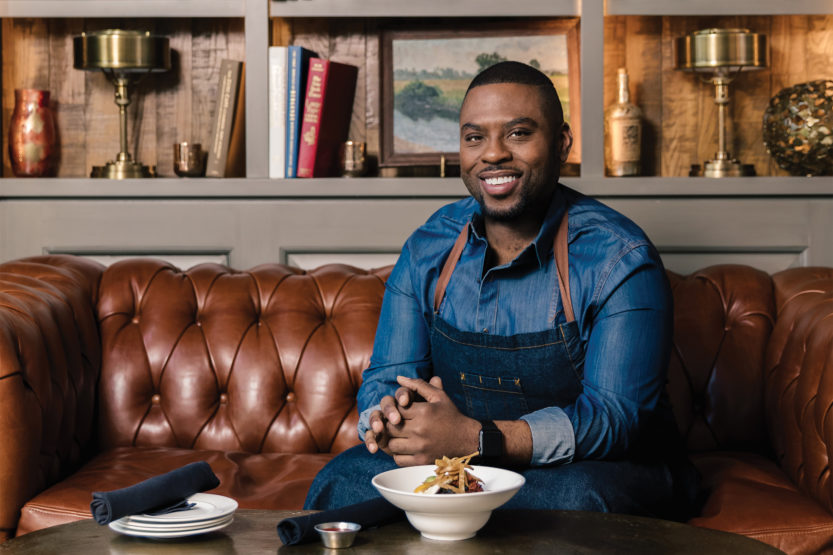Alumni Interview: Judson Todd Allen
 “I went into corporate America after I graduated,” says chef Judson Todd Allen, ’03 ACES, author of The Spice Diet. “Then I really decided to pursue my passion for food. It has been an awesome journey.” (Image by Lucy Hewett)
“I went into corporate America after I graduated,” says chef Judson Todd Allen, ’03 ACES, author of The Spice Diet. “Then I really decided to pursue my passion for food. It has been an awesome journey.” (Image by Lucy Hewett) Editor’s Note: Before this article was published, we were informed that Chef Allen had died from a heart attack. He was 36.
I was a food science and nutrition major at the U of I.
A lot of people don’t realize that food science is a tough curriculum. It’s similar to a medical school curriculum because you take a lot of biochemistry and chemistry. You take physics. It’s science-driven, engineering-driven. So I made it through, and I was happy. [Laughs] It really molded my career. It made me different in the culinary space.
I went to work for an executive search firm. There I was at 25, trying to place individuals into CEO and VP roles. I worked there for four years. It showed me a lot in a short period.
I started my own company, Healthy Infused Cuisine, to provide catering and health consultancy services. I also did a delivery service, taking healthy gourmet meals to clients in my area. And they loved it.
In my new book, The Spice Diet, I share my personal story. Ever since I was a kid, I’ve had a passion and a love for food. I used to dream about food. It did kind of go back to my grandparents. My mother couldn’t cook. [Laughs] My mother still can’t cook. I mean, it’s true, and she knows it.
My love and passion for food created an insatiable appetite—literally. I would get up at night and ransack the refrigerator. I don’t know if I was sleepwalking and eating. Later in life, I realized it was the beginning of a food addiction.
Many of us have lost weight and reached our goal, just to gain it back. I wanted to create a diet, a program, a plan. It doesn’t have to be a quick fix, because nothing is a quick fix. I give people the hope and encouragement they need to move along a better pathway for their lives.
In grammar school, I found myself turning toward not-so-good food—McDonald’s, the fast-food places. That’s what my taste buds craved: donuts, potato chips. My weight really got out of control. I was always the biggest kid in school. As a kid, one of the main things people bully you about is weight. And I’ve had to deal with that for a large part of my life.
My first year in college, I gained more than 70 pounds. In the cafeteria, I had access to food 24 hours a day. I would just eat and eat and eat. I would eat with friends, I would eat with my fraternity brothers.
It wasn’t until I graduated that I saw myself in a life-size photo—me, at close to 400 pounds. This overweight person, this obese individual. Food was silently killing me. It was taking me out. Now I’m about 215 pounds. I lost the equivalent of two people.
Many of us have lost weight and reached our goal, just to gain it back. I wanted to create a diet, a program, a plan. It doesn’t have to be a quick fix, because nothing is a quick fix. I give people the hope and encouragement they need to move along a better pathway for their lives.
I grew up with my grandfather’s fried catfish and grits. It was so amazing. So I created a Creole pecan-spice crust, which is really cool because it brings texture to the fish. It’s like you’re eating fried food, but you bake it.
Ice cream is one of those things I crave and I love. I could go through a gallon of that stuff. But it’s full of heavy cream and sugar and fat. So I use frozen bananas as the base for my ice cream. The frozen bananas have a kind of creamy consistency. I add in whatever toppings or things I want, like vanilla or peanut butter.
Most important, I stay away from salt and unhealthy fats. And sugar. Processed foods—things in cans and packages and jars.
I partnered with Don Thompson, the former president and CEO of McDonald’s Corp. Don’s vision was always to create a food-and-beverage incubator. And he did. It’s called Cleveland Avenue, and it’s located in the Fulton River District in Chicago. We take in clients who have from 20 stores to 200 stores, from 50 products to 5,000 products. We’re always looking for the next best thing as it relates to food and beverage.
The restaurant on our first floor is called Taste 222. I call it “the Disneyland of food.” It’s a place for ideation and creativity. Nothing like it exists anywhere else in the world. We’re at the forefront.

